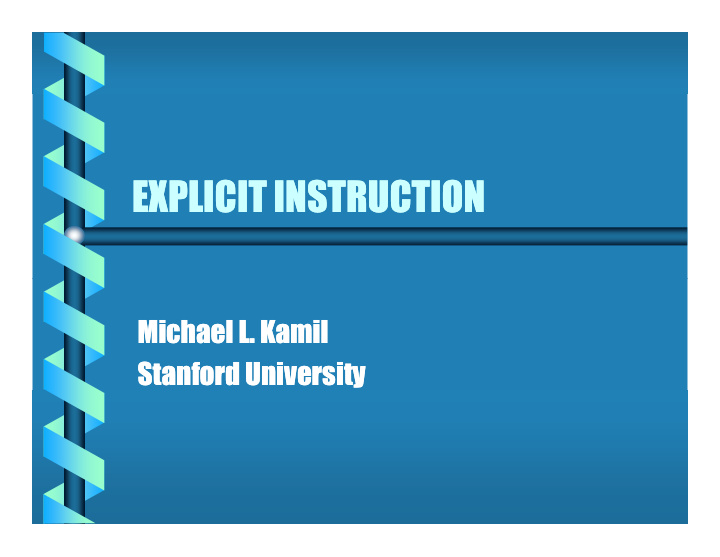



EXPLICIT INSTRUCTION EXPLICIT INSTRUCTION Michael L. Kamil Michael L. Kamil Stanford University Stanford University
What is Explicit Instruction? What is Explicit Instruction? • • Demonstration, modeling, explanation. Demonstration, modeling, explanation. • • Guided practice with feedback. Guided practice with feedback. • • Independent practice. Independent practice.
Explicit Instruction Explicit Instruction • • I DO IT I DO IT— —The teacher models and The teacher models and explains, “Watch me do it first.” explains, “Watch me do it first.” • WE DO IT WE DO IT WE DO IT—The teacher and students do WE DO IT—The teacher and students do The teacher and students do The teacher and students do • it together, with the teacher providing it together, with the teacher providing feedback, “Let’s do it together and I will feedback, “Let’s do it together and I will help you.” help you.” • • YOU DO IT YOU DO IT— —Students do it on your own. Students do it on your own. “Now you do it on your own. “Now you do it on your own. “ “
How To Do It How To Do It • • This is NOT a linear process. This is NOT a linear process. • Day 1 Day 1-- -- T, T & Ss. T, T & Ss. • • • Day 2 Day 2-- -- T & Ss, T, 4 Ss. T & Ss, T, 4 Ss. • • Day 3 Day 3-- -- T & Ss, 4 Ss. T & Ss, 4 Ss. • • Day 4 Day 4-- -- 2 Ss, T & Ss, T. 2 Ss, T & Ss, T. • • Day 5 Day 5-- -- 4 Ss, 2 Ss, 2 Ss. 4 Ss, 2 Ss, 2 Ss.
• Here is how to pair students: Here is how to pair students: • • Rank the whole class. Rank the whole class. • • Divide the class in half. Divide the class in half. • • Pair highest reader from top half to highest Pair highest reader from top half to highest • reader from bottom half. reader from bottom half. • Continue down in that order. Continue down in that order. •
How To Do It How To Do It • • Here are some rules of thumb: Here are some rules of thumb: • 1) Begin with modeling or explaining. 1) Begin with modeling or explaining. • • 2) Model and think 2) Model and think- 2) Model and think- 2) Model and think -aloud. -aloud. aloud. aloud. • • 3) Move to guided practice with students. 3) Move to guided practice with students. • • 4) Move from guided practice to students 4) Move from guided practice to students • working together. working together. • 5) Have students work together in 4s, in pairs. 5) Have students work together in 4s, in pairs. •
Summarizing Summarizing 1) Summarizing is one of, if not, the most 1) Summarizing is one of, if not, the most cognitively difficult cognitively difficult strategies to learn how strategies to learn how to do. to do. to do. to do. 2) It is very rare that textbooks teach 2) It is very rare that textbooks teach students or help teachers teach students students or help teachers teach students HOW TO summarize HOW TO summarize . .
Getting the Gist Getting the Gist 1. Name the “who” or “what.” 1. Name the “who” or “what.” 2. Tell the most important information about 2. Tell the most important information about the “who” or “what.” the “who” or “what.” the “who” or “what.” the “who” or “what.” 3. Say it in 10 words or less. 3. Say it in 10 words or less. * * Vaughn, et al. Collaborative Strategic Reading (CSR) Vaughn, et al. Collaborative Strategic Reading (CSR)
We went to the airport to meet my brother. His flight was delayed because of a storm. I had a hot dog while we waited. (25 words) We went to the airport to meet my brother whose flight was delayed by a storm. (16 words)
We went to the airport to meet my brother whose flight was delayed by brother whose flight was delayed by a storm. (16 words) We went to the airport to meet my brother. (9 words)
Recommend
More recommend